10 Facts About Hadrosaurus
By Mark Mancini

From Texas to Montana, the American West is bursting with dino fossils. Things are quite different across the Mississippi, where remains are much fewer and farther between. Still, the eastern states do have a few species of their very own. Hadrosaurus foulkii, for example, was a total Jersey thing—and it just so happens to be the continent’s most historically significant dinosaur.
1. Before Hadrosaurus Came Along, Nobody Had Ever Mounted a Dinosaur Skeleton.
Wikimedia Commons // Public Domain
Today, your standard dinosaur exhibit comes with a few skeletons (or at least skeletal replicas) posed in lifelike stances. But 147 years ago this was a pretty novel concept. In 1858, naturalist William Parker Foulke learned about some curious bones that had appeared near the sleepy borough of Haddonfield, N.J. His curiosity piqued, Foulke checked out the plot and promptly unearthed some more. His assorted fossils represented the most complete North American dinosaur specimen yet discovered. They soon found a home at the Academy of Natural Sciences in nearby Philadelphia.
By 1868, curator Joseph Leidy and British sculptor Benjamin Waterhouse Hawkins had started working on an ambitious new attraction. Replacing the bones they lacked with plaster casts and models, they erected Foulke’s creature, which was dubbed Hadrosaurus foulkii in his honor. Standing tall on its hind legs, the dinosaur became such a crowd-pleaser that the academy started charging admission for the first time to keep attendance under control.
2. It Was Named By the First Person to Solve a Murder Mystery with a Microscope.
Wikimedia Commons // Public Domain
In 1846—12 years before coining the word Hadrosaurus—Leidy was asked to examine the bloody shirt of a man being tried for homicide. The accused party had testified that these stains were only chicken blood, but Leidy’s high-tech (for the time) microscopic analysis identified their human origins. Faced with this damning evidence, the murderer confessed.
3. At First, Scientists Thought that Hadrosaurus Leaned on its Tail, Kangaroo-Style.
Wikimedia Commons // Public Domain
Today, we know that dinosaurs held their tails upright. But back when Hawkins and Leidy were assembling the Philly Hadrosaurus mount, paleontologists knew almost nothing about these creatures. Forced to take an educated guess, they went with a tripodal, kangaroo-like position.
4. Foulke’s Hadrosaurus Was Excavated From Marine Sediment.
After the dinosaur died, its body washed out to sea. Shark, ray, and oyster fossils appear in the same 80-million-year-old deposits.
5. Paleontologists Briefly Questioned its Status as a Legit Dinosaur.
Imagine this: You dig up a nice dinosaur skeleton and announce that it’s a Hadrosaurus. First of all, congrats! Now get ready to defend that identification. How can you be certain that this isn’t, say, a close relative instead? In order to figure this out, you’ll need to closely search the bones for distinguishing characteristics that Hadrosaurus—and Hadrosaurus alone—possesses.
Between 2006 and 2011, it looked like Hadrosaurus’ validity was on the line. Along with two colleagues, Dr. Albert Prieto-Marquez took a fresh look at every known scrap of material. He then concluded that nothing about the animal's anatomy set it apart from similar duck-billed vegetarians—so alleged Hadrosaurus fossils might have really belonged to a number of other dinosaurs. And with no standout features, we couldn’t justifiably label it a real genus anymore.
Or at least, so he thought in ’06. Five years later, Prieto-Marquez changed his tune. The biologist now feels that Hadrosaurus’ hip is unique enough to keep calling it a genuine, recognizable dinosaur. Phew!
6. An Eagle Scout Project Rediscovered the Original Hadrosaurus Site.
While trying to earn the BSA’s highest honor, most scouts organize some community service effort along the lines of building trails or fixing up old libraries—but Christopher Brees took a different approach.
Shortly after Foulke removed his Hadrosaurus, the coordinates of that historic excavation area became a mystery. Then, in 1984, Brees used old maps and old-fashioned detective work to pinpoint the exact location. Upon clearing up mounds of garbage that had been carelessly tossed there, his team used a 700-pound stone (which now boasts a handsome plaque) to mark the spot. Since then, Foulke’s dig site has become a National Landmark. And needless to say, Brees got his Eagle.
7. Haddonfield Has a Stream Named After Its Prehistoric Hero ...
WikimediaCommons // Public Domain
Brees’s rock actually rests about 10 yards ahead of the ravine that introduced the world to Hadrosaurus foulkii. A murky creek runs through it, which is called Hadrosaurus Run.
8. … And a Life-Sized Hadrosaurus Sculpture Downtown.
Affectionately referred to as Haddy, this 8-foot high, 1200-pound gal is the toast of Lantern Lane. When sculptor John Giannotti built it in 2003, he got a little help from eager school kids, who were each permitted to plop on a handful of clay.
9. Boss Tweed’s Thugs Destroyed Another Model That Was Meant for Central Park.
Wikimedia Commons // Public Domain
Hawkins—who had previously populated London’s Crystal Palace with his to-scale dinosaur replicas—envisioned a 19th-century Jurassic World right in the Big Apple’s core. At the invitation of city planner Andrew Green, Hawkins got to work on an all-new Mesozoic ensemble for a future Central Park museum. Unfortunately, that project fell through. Tammany Hall’s corrupt machine ran said territory, and its head honcho didn’t much care for the whole idea. Like many people, Hawkins hated Tweed. But unlike many people, he was brazen enough to denounce him in public. Big mistake: Tweed’s men broke into the artist’s studio, where they demolished every last dinosaur—including a lovely Hadrosaurus.
10. Hadrosaurus foulkii is New Jersey’s Official State Dinosaur.
Owl's Flight, Flickr // CC BY-NC-ND
Led by their awesome teacher Joyce Berry, fourth graders at Strawbridge Elementary in Haddon Township embarked on a 4-year push to clinch this honor for Hadrosaurus. Governor Jim Florio signed the bill into law on June 13, 1991. “We were known … as the shortest lobbyists, but the loudest,” Berry said.